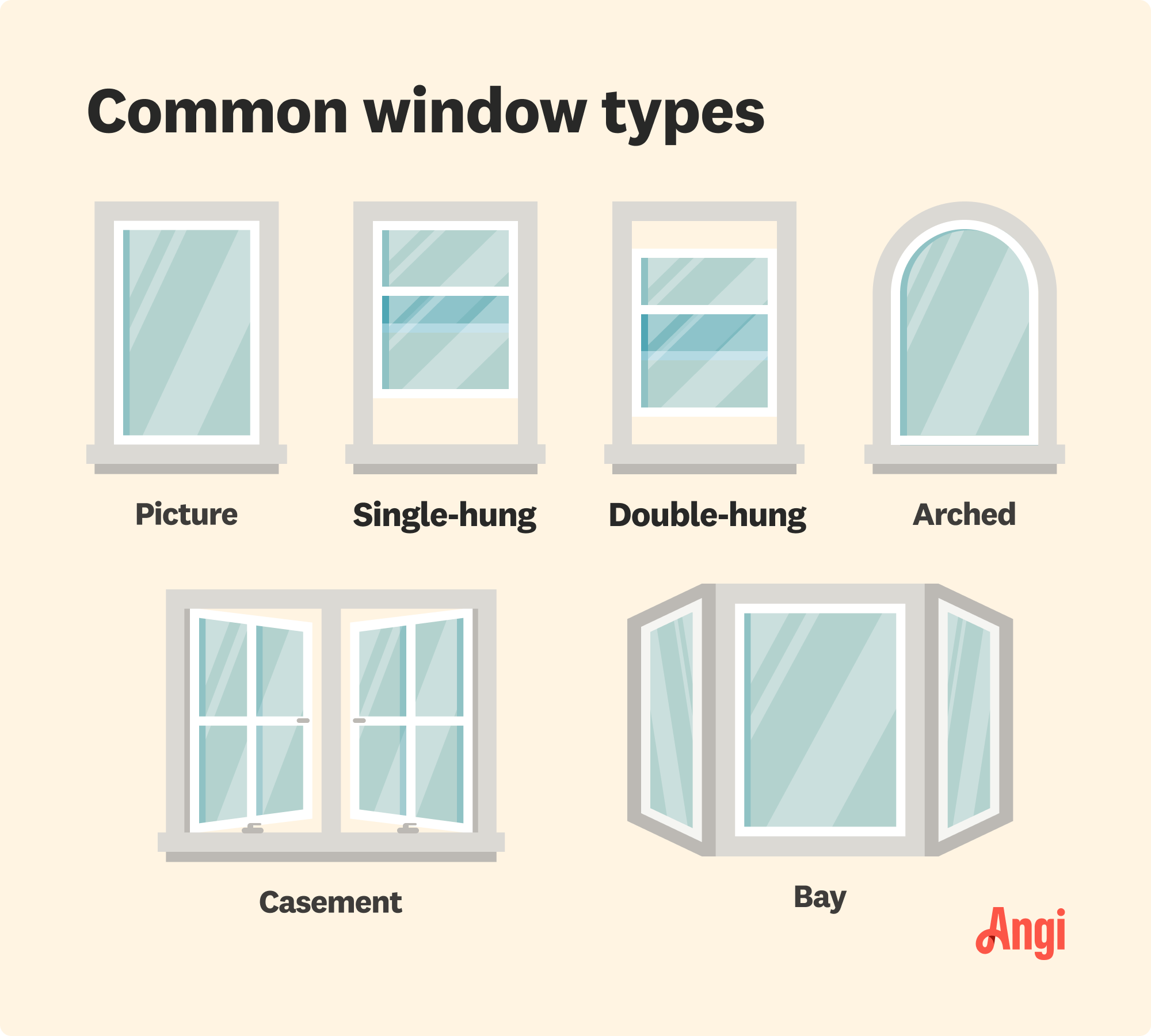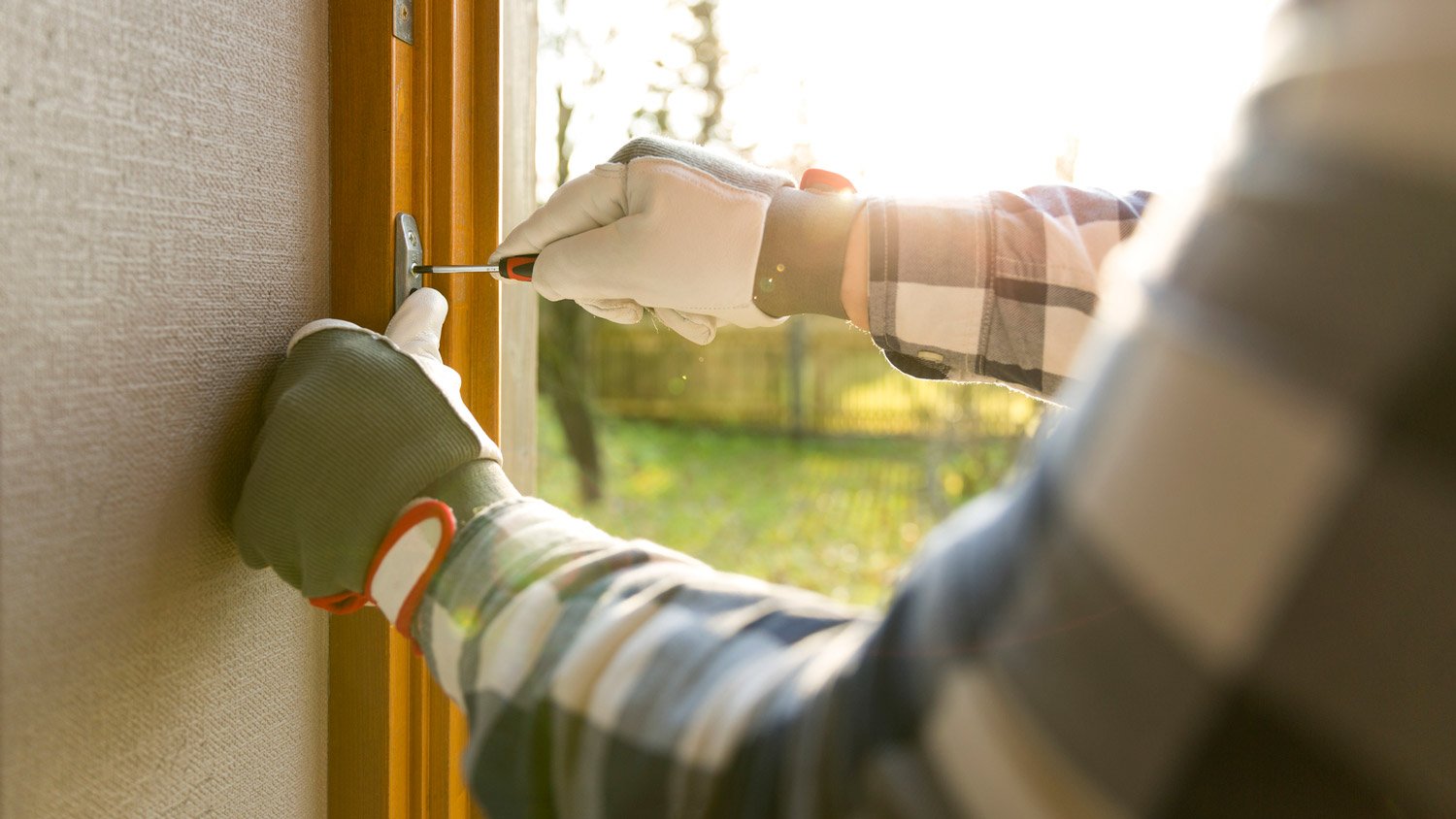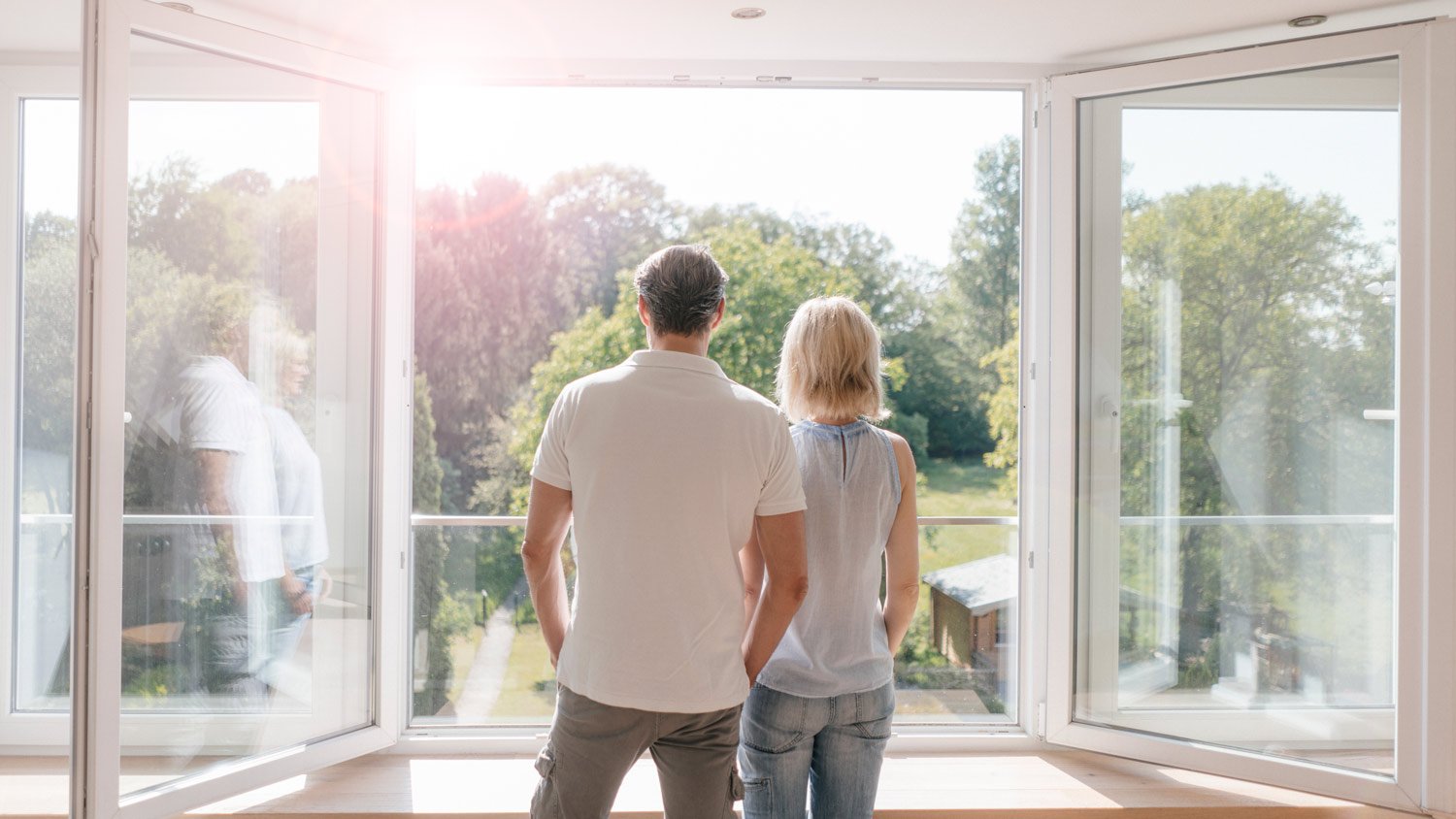How Much Does Window Replacement Cost? [2025 Data]
Homeowners spend an average of $7,357 on window replacement. When determining your personalized quote, window replacement pros consider the window material, style, and size.


Fiberglass and composite frames cost three times as much as aluminum and twice as much as vinyl, but they last longer and provide more value over time.
Larger windows like bay windows and those with more complex opening mechanisms like casement windows will always be more costly than simple single-hung windows.
Downgrading to single-pane glass can reduce your cost per window by 50% to 75%, or you could maximize efficiency and sound insulation and pay 100% more for triple-pane.
Expect to pay around $100 to $300 per window for labor, depending on the size and type of window.
The average window replacement cost is $7,357 per project. Most people pay between $3,445 and $11,835 in total, depending on window size, type of material, number of windows, number of panes, brand, and the cost of labor. You can expect to spend between $300 to $2,500 per window, including labor and materials.
Installing new windows is a great way to renew your home and keep it well-insulated. Plus, it can help save money on your energy bills. Here’s everything you need to know about window replacement costs so you can budget for the right materials and labor.
Window Replacement Cost by Number of Windows
On average, window replacement costs $750 per window—and most homes have around 10 windows. Here’s a breakdown of what you’ll pay based on how many windows your home has. Speaking with a local window contractor is the best way to accurately estimate your cost, especially if you have multiple windows to replace. For example, the cost to replace 25 windows can range from $18,000 to $20,000, while the average cost to replace windows in a 3-bed house is closer to $6,000 to $12,000.
Here's what you can expect to pay for window replacement based on the number of windows:
Window Replacement Cost by Frame Material
The material you choose is a major factor in calculating the cost of a new window. Popular choices include vinyl, wood, fiberglass, aluminum, and composite. Custom, lavish, new construction, or extra-large projects can add between 25% and 50% to the total project cost.
Below you can find the average cost of window replacement by frame material:
| Material | What to Know |
|---|---|
| Aluminum | Not as energy-efficient |
| Vinyl | Low-maintenance and durable |
| Composite | Extremely durable and long-lasting |
| Wood | Susceptible to mold and rot |
| Fiberglass | The longest-lasting option |
Window Replacement Cost by Style

The size and style of your window can greatly impact the cost of your window installation. Here’s a breakdown of the different styles and their average price ranges. Consult a window contractor near you to discuss the best options for your home.
| Window Type | Average Cost, per Window | Qualities |
|---|---|---|
| Arched | $350–$1,000 | Boasts unique designs and increased natural light. |
| Awning | $400–$950 | Excellent ventilation and often more secure than other window types. |
| Bay | $900–$7,100 | Improve curb appeal and provide expanded living space. |
| Bow | $1,500–$6,500 | Can provide visual interest and enhance views of the outdoors. |
| Casement | $150–$1,000 | Provides excellent water resistance and many customization options. |
| Custom | $1,000+ | Perfect for non-standard window sizes or shapes. |
| Double-hung | $150–$650 | Easily cleaned but can have complex installation issues. |
| Egress | $100–$700 | Easy operation and clear opening for safe exit. |
| Energy-efficient | $120–$1,500 | Can help to reduce energy costs and overall home drafts. |
| Floor-to-ceiling | $700–$5,000 | Modern design with abundant natural light but might pose privacy concerns. |
| Folding | $500–$900 | Blend indoor and outdoor spaces with modern designs. |
| Hopper | $150–$650 | Compact design that is easily maintained. |
| Jalousie | $170–$380 | Slats allow for maximum ventilation and natural light control. |
| $100–$400 | Minimalist design and flexible ventilation, but needs routine maintenance. | |
| Picture | $65–$700 | Offer no ventilation but do offer abundant natural light. |
| Single-hung | $100–$400 | Easy operation and timeless design, however, provide limited ventilation. |
| Skylight | $900–$2,500 | Provide unique architectural elements to the home, but may be more difficult to clean. |
| Storm | $90–$400 | Helps to significantly reduce drafts and noise while protecting from the elements. |
Window Replacement Cost by Glass Type
Not all window glass is created equal, and because of that, the glass type you choose for your new windows will impact the total cost. Different glass types can provide various levels of thermal and sound insulation but may require more maintenance.
Here is the average cost of window replacement you can expect by the type of glass:
| Type of Glass | Qualities |
|---|---|
| Single-pane glass | Most cost-effective option and easy to maintain, however, offers poor insulation. |
| Double-pane glass | Helps maintain consistent indoor temperature and is durable, but is more expensive. |
| Triple-pane glass | Best choice for insulation and enhanced home comfort, however, is the most expensive option. |
| Tempered glass | Increased strength compared to other glass but offers limited customization options. |
| Low-emissivity (Low-E) glass | Best energy efficiency option but has the potential for reduced natural light. |
Window Labor and Installation Costs

If you pay a pro to install your new windows, you'll need to pay labor costs. These costs usually range from $100 to $300 per window, depending on the window's size, type, and location. However, more complex installations can cost as much as $600 or more per window.
Additional Window Replacement Cost Factors
You’ll also encounter a handful of additional factors that could influence the final cost of your window replacement, like the number of panes, type of glass, energy efficiency, window location, home age, and more. Check out these additional cost factors before you press enter on your calculator.
Energy-Efficient Upgrades
You can invest in add-ons to make your windows more energy-efficient. Energy-efficient windows cost between $50 and $1,650 per window, depending on your chosen upgrades.
While these window upgrades come with higher up-front costs, they can also save you between 7% and 15% in annual energy costs. Plus, by upgrading your home’s insulation, you may qualify for tax credits under the Inflation Reduction Act.
| Upgrade Type | Cost per Window | Best Use |
|---|---|---|
| Low-E coating | $300–$1,000 | Reduce heat loss by up to 50% |
| Tint | $50–$1,650 | Reduce heat, cut down on sun glare, and block out UV rays |
| Laminate | $60–$300 | Reduce noise and protect against moisture |
| Weatherstripping | $150–$450 | Seal against air leaks |
Window Location
A window's location will impact the replacement cost. For example, ground-floor windows cost less to replace than ones on higher levels.
Here’s what you can expect to spend based on window location:
Home Age
Replacing a window on a newer property will often cost less than replacing one on an older property. This price difference is often because the latter may require refitting, demolition, and potentially custom-made pieces to ensure the new installation is up to code. Pros may also need to remove or replace additional parts, increasing your final bill.
Structural Repairs
In some cases, window replacements reveal the need for structural repairs in a home. For example, any cracks in the drywall or stone masonry that might have formed from replacing the window will require additional expenses and labor to repair.
Project Cleanup
Although many professional contractors include the price of old window removal and cleanup in their final window replacement costs, some may charge an additional removal fee. In these cases, expect to pay an added $55 to $65 per hour for extra labor.
Full-Frame Window vs. Retrofit Window Replacement Costs
Generally, full-frame window replacements cost more than retrofit replacements.
| Replacement Type | Cost per Window |
|---|---|
| Full-frame | $180–$1,500 |
| Retrofit | $100–$300 |
| Window glass | $200–$400 |
DIY Window Replacement Costs vs. Hiring a Pro
If you're replacing multiple windows or installing a custom or complex window, it's best to hire a window replacement company near you. Hiring a professional will help you avoid costly problems like mold, broken code regulations, cosmetic damage, and structural issues. Not to mention, you’ll steer clear of a couple of days’ worth of weekend labor.
There are also safety concerns. Window replacement often involves working at heights, handling heavy materials, and using power tools. You might find that these challenges are risky to handle yourself, whereas a professional has the expertise to avoid injuries or damage to your property.
Hiring a pro costs about $100 to $300 per window or around $50 to $65 per hour. While it may take a DIYer about six hours to replace a window, a pro can get this job done in under an hour. Window contractors can usually replace 10 to 15 windows in a day.
When Should You Replace Your Windows?
Over time, windows can wear out, leading to higher energy bills and safety concerns. Plus, visible damage around your windows can detract from the overall look of your home.
Knowing when to replace your windows can help you avoid costly repairs and give your home a fresh, stylish look. Here are some signs it’s time for new windows:
You want to reduce noise.
You’re experiencing drafts.
You notice condensation inside the glass.
You struggle to open or close the windows.
You want to enhance curb appeal.
You see damage, such as cracks or rotting frames.
Tips for Saving on Window Replacement Costs
Besides DIY, you can reduce window replacement costs by:
Comparing estimates from multiple installers
Choosing energy-efficient windows to reduce long-term energy costs
Opting for standard as opposed to custom windows
Taking advantage of potential tax credits for installing energy-efficient windows
How Angi Gets Its Cost Data
Home is the most important place on earth, which is why Angi has helped more than 150 million homeowners transform their houses into homes they adore. To help homeowners with their next project, Angi provides readers with the most accurate cost data and upholds strict editorial standards. We’ve surveyed over 10,000 real Angi customers about their project costs to develop the pricing data you see, so you can make the best decisions for you and your home. We pair this data with research from reputable sources, including the U.S. Bureau of Labor Statistics, academic journals, market studies, and interviews with industry experts—all to ensure our prices reflect real-world projects.
Want to help us improve our cost data? Send us a recent project quote to costquotes@angi.com. Quotes and personal information will not be shared publicly.
Frequently Asked Questions
Before you replace your windows, check your home warranty. Many home warranties don’t cover windows at all, while some have specific clauses about what they will and will not cover and what might void the warranty. If you have any questions, reach out to your insurance specialist, and never make assumptions.
While you don’t have to replace all your windows at once, doing so will likely save you money in the long run. Installers often quote a flat rate for the job because their overhead remains the same for a partial or full day's work. Additionally, from a curb appeal and home value perspective, matching windows are appealing to potential buyers. If you plan to replace just some of your windows, experts recommend that you replace no fewer than five to eight at a time.
ENERGY STAR®-certified windows are the most energy-efficient windows on the market. This certification means that the window meets strict efficiency guidelines set forth by the Environmental Protection Agency. While they might cost more upfront, they can save you money on your energy bills in the long run. ENERGY STAR®-certified windows lower household energy bills by an average of 12% annually.
Fall and winter are the best times to replace windows. Typically, the demand for window replacement spikes in the spring and summer because people are concerned about replacing their windows in colder months. While spring or summer window replacement means you don’t have to deal with cold drafts during the project, there will also likely be a longer waitlist, and you may end up paying more.
Replacing your windows in the fall or winter when demand is down often means that your pro will finish your project faster, and you’ll pay less than you would in warmer months.
Most properly installed and maintained windows last between 15 and 20 years. Fiberglass windows last much longer than your average window. Since they don’t warp from temperature changes, rust, or rot, you might be able to hold onto fiberglass windows for up to 40 years. On the other hand, poorly maintained wood windows may only last for a few years.















